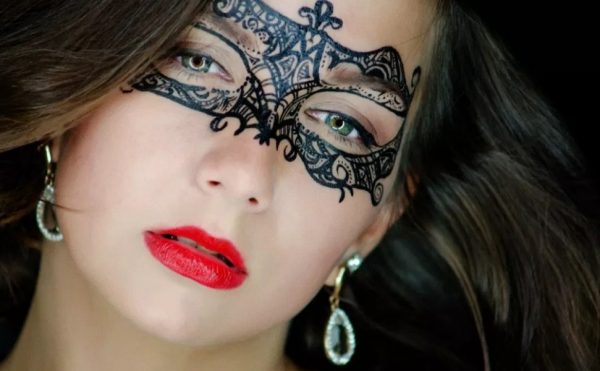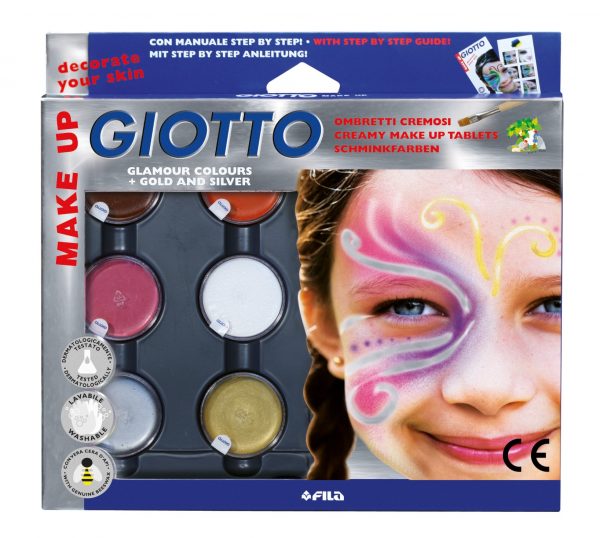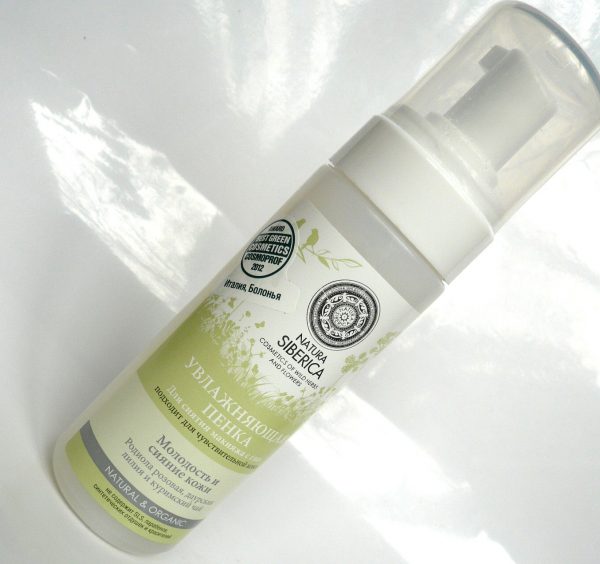A great idea for a children's party is a theme party. So that the images of the kids correspond to the idea, you can use face painting. The choice of paints should be given close attention, because poor-quality materials can cause allergies.
- Is face painting safe for a child?
- Types of colors and selection rules
- DIY face painting
- New paint activation
- Paint reactivation
- How to apply paints
- Watery
- Mascara Consistency
- Cream
- Sticky
- Dry
- Makeup Technique
- Face Art Supplies
- Face painting
- Face Hygiene
- How to remove face paints?

Is face painting safe for a child?
Face painting, or water, oil, wax based paint is widely used in face art - the art of face painting. Unlike tattoos and other methods of decorating the skin, face painting is temporary and is washed off after the first contact with water, since it is applied only to the top layer of the skin.

Face painting paints must be based on natural or harmless synthetic components: coloring pigments, glycerin, water, petroleum jelly, polymers, thickeners. Their composition is specially selected so that the finished product has the following properties:
- non toxicity;
- the ability to draw both clear lines, and transitions, shading;
- elasticity, lack of cracking after drying;
- brightness, saturation of tones;
- quick drying;
- ease of application;
- the possibility of layering tones.
Unlike acrylic materials, gouache and watercolors, face paints do not provoke allergies and irritations. They do not clog pores, allowing the skin to breathe, and do not cause dryness, itching, or other undesirable reactions. It is easy to wash funds from the face and clothes if they accidentally get on it.
All of these properties are inherent only in high-quality face painting. If you purchase a low-grade composition, it is quite capable of leading to skin rashes and allergic reactions. Due to the very delicate skin, it is not recommended to perform drawings on the face in children up to 2-3 years old.

Types of colors and selection rules
Face painting is made in various forms, packaging, volumes, produced by domestic and foreign manufacturers. The main types are:
- Pressed. It is a set of professional tools for painting leather. Its shades do not fade, they look juicy, bright in any light. Typically, compressed face painting includes calcium carbonate, paraffin, and gum. The composition gently lays on the skin, does not spread, and then it is easily washed off with warm water.
- Spray paint. It can be applied not only to the face, but also to the hair and body. It is very convenient to apply it, it dries quickly, does not crumble and does not crack, does not stain clothes, has no smell. Such compositions are ideal for working with stencils.
- Liquid face mask-mehendi. It includes a natural component - henna. It is not intended for children's face painting, as it lasts on the skin for up to 2-3 days.
- Cream face painting. It is made on the basis of oils or waxes.It is quite resistant, it requires the use of oil emulsions, soaps for washing off. The drawings made with these paints look very attractive, the color palette is quite rich.
- Face painting pencil. Funds in the form of markers, crayons, pencils, felt-tip pens are sold individually or in sets. To apply them, you do not need brushes, sponges, water. Only shading is more convenient to produce with small brushes.
- Face painting in split cakes. It is an unusual type of paint, reminiscent of plasticine in plastic packaging. Designed to quickly create rainbow patterns, unusual backgrounds.
- Pallets with face painting. Classic sets reminiscent of ordinary watercolor, equipped with brushes. They include the main colors of the gamut, many also contain shades with metallic, fluorescent paints.

It is impossible to replace means for face painting with ordinary gouache or other compositions for drawing on paper, stained glass. They will cause irritation on the skin, can provoke allergies. Before buying, you need to make sure the safety of the composition and some other points:
- Release form. For young children, crayons and pencils are more suitable, which you can draw faster. For older children, you can use paints of any shape.
- Quality. The product should not have an unpleasant odor, be divided into fractions, its texture must be uniform.
- The number of shades. To create a beautiful picture you need to buy a set of 6 colors, not less, although some thematic images include fewer colors.

DIY face painting
The cost of one jar can reach 200-500 rubles, so many parents have a desire to save money and make colors on their own. There are the following recipes for making face painting from safe ingredients:
- Combine 3 tablespoons of starch, 1.5 teaspoons of any cream (preferably baby), 1.5 teaspoons of water. Stir the mixture until smooth, placing it in a clean container. Add the food color of the desired color into the mixture, mix until the desired shade is obtained. If the paint is too thin, add more cream or starch.
- Take 2 tablespoons of corn starch, a tablespoon of fat cream, a teaspoon of water, food coloring. Combine the components, mix, so that a mass with the consistency of sour cream is obtained.
to contents ↑
New paint activation
Some products for face painting, which are sold in dry form or cakes, require activation. To do this, you need only ordinary water, which is sprayed with materials after being placed in the spray gun. You can also wet the paint with a wet brush to obtain a creamy or watery texture (depending on need).
Wax-based paints need more fluid to activate, so they will need to be moistened more actively. Also, it is necessary to spray neon products more strongly, which show their color in full only with sufficient humidity. A minimum of water is needed for glycerin colorants, which are already quite soft. It is best to activate the paint this way:
- Take a brush in your hand, wet it with water.
- Rotate to make a small depression in the paint.
- Give the color in the “crater” a creamy consistency, and leave the rest of the mass in a solid state.

Paint reactivation
Previously used paints dry out over time, and a crust forms on their surface. If the material is no longer needed, it must be allowed to dry, and the next time reactivated, adding a little water.
How to apply paints
Professionals can work with face painting of various types. Depending on the consistency, there are some differences in the results, which must be taken into account when applying drawings.

Watery
The paint, diluted to a liquid state, allows you to get original streaks, splashes.The watery texture creates realistic drops that are very difficult to draw artificially, and this takes a minimum of time. If such a color is diluted even more, they can draw shadows.

Mascara Consistency
Such paint resembles ink (ink) for writing with a pen, which was widely used before the invention of pens. It is thick enough to draw clear lines. The consistency of the carcass is ideal for creating black and other dark contours, graceful curves, sharp tips.

Cream
Most often used when creating face painting, because it most fully reveals the depth and saturation of the paint. When it comes to a wax product, the creamy texture allows you to draw clear lines, droplets, curls. It is convenient to make dense coatings with glycerin colorants of such a consistency.

Sticky
A sticky effect can be obtained from wax-based paints by adding a minimal amount of water. Usually they are used to make dense, clear patterns.

Dry
This texture is a little drier sticky and is created on paints with glycerin in the composition. It is used for classical shading, working with stencils, in the technique of shading on dry, to create the effect of "Tirex skin".

Makeup Technique
The choice of drawing depends on the preferences of the child or adult, the theme of the party, the imagination and artistic abilities of the master. Before starting work, you need to remove hair from the face, securing it with a bandage, dress the model in home clothes, especially if this is a baby up to 3-5 years old. Face painting is easily washed, but the mood from dirty things can go bad.
The most popular drawings for children are:
- muzzles of animals;
- insects
- flowers
- superheroes;
- fairies
- patterns, ornaments;
- fairy tale characters.

Face Art Supplies
It is worth taking care in advance of the availability of the necessary tools and supplies to create a beautiful face painting. It will be required:
- brushes of different thicknesses made from natural materials (better than a mullet for each color);
- small sponges for shading and painting large areas;
- disinfectant (if you have to draw on the faces of different people);
- cups of water for washing brushes, sponges;
- paper towels, wet wipes, cotton buds;
- soap.

to contents ↑To create interesting effects, fluorescent pencils, stickers for temporary tattoos, sparkles, rhinestones, and cosmetic rice powder may also be needed.
Face painting
First, you should test the paint for allergies, which is recommended to be performed even with respect to the highest quality products. The tool is applied to the inner side of the elbow, wait 5-10 minutes. If there are no redness and rashes, you can safely apply the material on the face.
First of all, when creating a face painting, a tone is applied - it should be even, smooth. To create it, the sponge is moistened and squeezed out well, and the paint is applied in smooth circular movements. Long strokes should not be done: after drying, they turn into ugly stripes. After drying, the tones are applied to the details and contours of the picture with brushes. They are held at a right angle, like a pencil, while wetted with paint lightly so that it does not drip and drip.Allow the drawing to dry, if necessary add special effects (for example, sparkles).
to contents ↑
Face Hygiene
If an allergic reaction develops during a face painting, the paint is immediately washed off with soap and a nourishing cream is applied. Brushes must be washed with soapy water. Before face painting to the next person, all instruments are thoroughly disinfected.
How to remove face paints?
Face painting is easily washed off with plain water. If it is made on an oil or wax basis, for washing you will have to use soap or cosmetic foams, milk. Sequins are quickly removed with adhesive tape, which is glued to the corresponding area of the skin for a couple of seconds.

Face painting is able to diversify leisure and make more vivid the impression of parties and holidays. To do this, you need to use pre-prepared stencils and special paints, and then each parent can play the role of an artist.




